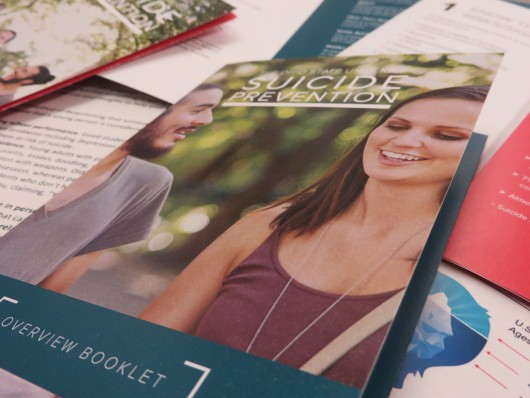
Brochures from the Ohio State Suicide Prevention Program. Photo Illustration by Amanda Etchison and Alex Drummer | Editor in Chief and Managing Editor of Content
This is part two of a two-part series on mental health and college students. Part one can be read here.
As chair of the Department of Psychiatry and Behavioral Health at Ohio State, Dr. John Campo is often sought out when it comes to questions regarding mental health and suicide.
Yet it was while he was still in medical school when Campo learned firsthand the value he can have in helping those struggling with thoughts of suicide.
Campo said he had a friend who was “badly depressed” and explained how he and roommates offered their support. His friend did not commit suicide, but when he looks back on that situation, Campo said he still thinks he could have done more to help.
“We certainly cared about him, and we were up close and personal with him, but I think we could’ve done more,” he said. “This individual, we probably should’ve called his parents, we should’ve taken him by the hand and reached out to services, but he was very private, didn’t want his parents to know, didn’t want his friends to know, and we thought we were doing the right thing by ‘respecting his privacy.’ In retrospect, we probably didn’t do him a service.”
Drawing on this experience, Campo said he hopes others facing similar situations are able to understand that mental health professionals are available for individuals contemplating suicide, which is the second leading cause of death for persons aged 15-34 years, according to the Centers for Disease Control and Prevention’s Suicide Facts at a Glance 2015.
From services provided at the Wexner Medical Center to university-wide suicide prevention programs to simply asking a friend, “Are you OK?” there are many options available at OSU for those looking to access care on campus.
Medical resources at OSU
The OSU Wexner Medical Center is able to offer the most “intensive level of service” for individuals struggling with the issue of suicide, Campo said.
“We have 24/7 psychiatric emergency services here, crisis assessment, linkage and management services, that are available for folks who need the highest level of care,” he said.
Other services offered at the OSU Wexner Medical Center include long-term inpatient psychiatric care, partial hospitalization and a crisis unit geared more toward brief stays in a hospital setting, Campo said. He also said the medical center offers specialized treatments such as transcranial magnetic stimulation, a noninvasive method that uses an electromagnetic coil to send magnetic pulses through the scalp in order to stimulate the nerve cells in the region of the brain that controls mood.
Campo said the Wexner Medical Center is able to “provide treatments beyond the standard psychotherapeutic treatments and medication treatments,” and he added that a strong connection between services provided by the medical center and those provided by the university is imperative for campus-wide success.
“We also do a lot of very straightforward outpatient treatment, although our capacity for that needs to grow for us to be able to serve a campus this size in collaboration with our colleagues over in the consultation center and student health,” he said. “Right now, there are lot of committed groups of folks. I think that we could be better coordinated, and I think that many of us are working very hard to do this.”
Peers as a resource
The university expanded its efforts to fight this problem when it created the OSU Suicide Prevention Program in 2007. Two student groups are an extension of this program.
One of these groups is Peers REACHing Out, which is comprised of students who help the Suicide Prevention Program spread its REACH message. REACH stands for recognizing warning signs, engage with empathy, ask about suicide, communicate hope, help access care and treatment.
“They started it because research has found students are more likely to turn (to) other students with problems like this, and we think they are more likely to take it better coming from us talking about such a sensitive topic,” said Ciara Coriell, president of Peers REACHing Out.
Coriell, a fourth-year in psychology, explained that group members try to use their presentations as a platform to break down the stigma tied to suicide and mental health. The group believes that it is crucial to educate students on the issue of suicide because they will often be the ones to come in contact with it.
“Your friends, your peers are more likely to turn to you, so if you know what to look for, you know how to start a conversation, you have the resources, then we really believe you can save a life, and it’s been proven you can make a difference,” she said.
The other student organization, Buckeye Campaign Against Suicide, was created in 2010 by a group of OSU students in order to increase suicide prevention and awareness, according to the group’s website.
“As a student organization, we have weekly meetings where we work to educate our members on a wide range of mental health topics. We bring people in a lot to talk about their own special area of mental health,” said president of the Buckeye Campaign, Kayla Higginbotham.
The group puts on several events as an organization every year.
“We did an event at the beginning of the semester to kind of get students talking about mental health and suicide prevention more. And then second semester, we put on a huge event, RUOK? Day, where we educate students on how to ask the question ‘Are you OK?’ and then kind of what resources are available,” said Higginbotham, a fourth-year in psychology and women’s studies.
During finals week, when students might confront additional stress, the Buckeye Campaign holds meetings focused on relieving stress.
“We’ve done a couple things. We tried art therapy. We suggested some mediation sites where you can go through like a guided meditation, and we’ve just really been focusing less on heavy subjects and more on just stress relief,” Higginbotham said.
Though it can be easier for students struggling with their mental health to reach out to peers, Campo said this can be problematic.
“The important thing is to reach out and talk to somebody to get help. And I would encourage you to reach out to somebody who is a professional, but talking to your peers is a good thing,” he said. “What you have to remember, though, is that your peers might not always know what to do.”
Higginbotham has had experience dealing with this issue during her involvement in the Buckeye Campaign.
“I have so many friends come up to me and be like, ‘Here’s my problem, how do I deal with this,’ and although I do have some advice I can give them, it’s hard for me because I’m not actually a mental health professional,” she said. “So that’s been hard just because I have a lot of people come to me thinking that I know everything about this when I’m still a student.”
Another challenge that Campo said he feels students face when helping their peers is the idea of invading each other’s privacy. He said oftentimes people might not be comfortable talking about their mental health concerns unless someone reaches out first.
“(People struggling with thoughts of suicide) don’t want to be a burden. They may very much welcome that kind of caring … there is no substitute for that,” he said.
Higginbotham reinforced that, at the end of the day, speaking up and seeking help are crucial.
“I always just want to tell people that it’s OK to not be OK and that there are so many resources available on campus and that if anybody wants to be a part of our group, we are full of survivors and we’re full of passionate students and we’re full of just caring students who would love to have any student be a part of our group,” she said.
Importance of education
The OSU Suicide Prevention Program focuses much of its efforts on educating those in the campus community about mental health and suicide. This education helps break down stigma, Matthew Fullen, the program manager, said.
“One of the primary missions that we have is to spread the word about suicide prevention. We want to teach students, staff and faculty that suicide is preventable — that mental health stigma can be eradicated,” Fullen said.
Though the program does a number of things, its “bread and butter” is the REACH training, Fullen said. These 60- to 90-minute training sessions aim to equip students, faculty and staff with the ability to recognize warning signs of suicide, ask anyone they might be concerned about whether they are OK and ultimately help those individuals access resources on campus.
Fullen said the program has currently trained more than 1,000 people this year. He said they hope to train 5,000 students, staff and faculty by May 2017.
“This is something that’s been in existence for several years, and we want to make sure that everyone on our campus knows about it as a resource,” Fullen said. “We get a lot of great feedback from individuals who go through the training, and they find that the training allows them an opportunity to learn about how to talk about mental health and suicide prevention, and it gives them some pointers on what to do if they’re concerned about a friend or a classmate or a student.”
Though several resources are already in place at OSU, House Bill 28, which was passed this year, will require other public institutions of higher education in the state of Ohio to have suicide prevention resources available to students.
Fullen said OSU is committed to making sure these programs are implemented at other universities so all students have proper access to education and resources.
“This was passed in an effort to combat the rates of suicide and mental health concerns that are taking place on college campuses,” Fullen said. “We’re working directly with leaders across the state, a state representative, to implement House Bill 28 so that by next fall of 2016 all public colleges and universities in the state of Ohio will have all sorts of resources available for their student body and for their staff members as well that teaches people about the warning signs of suicide and how to respond.”
At OSU, Fullen said the Suicide Prevention Program hopes to do more than teach about suicide prevention.
Rather, it intends to create a campus culture centered on caring for one another. By creating this culture where students, faculty and staff are comfortable asking those sometimes difficult questions, it breaks through the stigma — which helps people get the resources they need, Fullen said.
“What we want to do is to let people know that suicide prevention is something that requires every one of us to share the responsibility of looking out for each other and having the courage to be able to ask the question, you know, ‘Are you really doing OK? Are you really thinking about suicide? How can I help you?’” he said.
More information about suicide-related services is available at suicideprevention.osu.edu. The Franklin County Suicide Prevention Coalition hotline is 614-221-5445.
This series was made possible by the generosity of The Lantern and Ohio State alumna Patty Miller.


